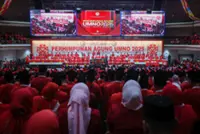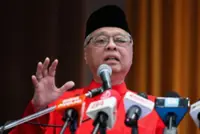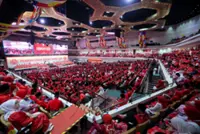Two women from the Kadazan Dusun ethnic group, dressed in their traditional attire, putting up accessories on display at their exhibition booth. — THOMAS YONG/The Star
Thousands impressed by different races, cultures at JB event
THOUSANDS of people from all walks of life, both young and old, flocked to the outdoor event space of Angsana Johor Baru Mall, Johor for the National Unity Week celebration.
The four-day event, held for the first time in Peninsular Malaysia, featured a long list of activities and programmes including esports competitions, displays by the army and police, Jualan Rahmah and a history exhibition.
However, what stood out was a unique exhibition dubbed “Rumah Kami” (our house) featuring 22 ethnic groups in Malaysia.
ALSO READ: Native folk build traditional homes to showcase culture and heritage
The display of three traditional Orang Asli houses from the Seletar, Mah Meri, and Semai tribes, as well as a longhouse of the Iban ethnic group garnered a lot of attention.
StarMetro spoke to visitors and the “Rumah Kami” exhibitors during the event, which was held from May 23 to 26, to find out about their experiences.
Law firm manager Suhaniza Salihan, 42, said she did not expect to learn so many new things about her fellow Malaysians when she visited the fair with her children.
“I found out about the event through social media and want to expose my children to the concept of unity from a very young age.
“It is a very important lesson to impart to the younger generation, especially as citizens of a multiracial country like Malaysia.
“However, when we got here, I found out that there were also a lot of things that I was not aware of about other ethnic groups in our country. Like my children, I also learned many things from the National Unity Week,” she said.
She said she had learned about the Murut, Rungus and Bajau ethnic groups from Sabah and also checked out the traditional food and cultures of people of other ethnic groups.
Another visitor, retiree K. Madhavan, 63, said he came all the way from Chaah, Segamat, with his friends and neighbours to experience the exhibition.
“I found out about the National Unity Week from a friend and was very impressed by it,” he said.
“I think we definitely need to have more events like this in the future. The more we know and understand about the cultures of others, the better we are in embracing the spirit of unity,” he said.
University student and Johor Unity ambassador Lim San Shien, 23, echoed a similar sentiment, adding that it was a very good platform to promote integration among people of various backgrounds in the country.
“I am aware that Malaysia is a diverse country but I didn’t know that we have such a large number of ethnic groups, especially in Sabah and Sarawak,” he said.
“It is truly a unique and special experience. I feel we should have more programmes like this in the future, not just in Johor but in other states as well.”
During the event, Lim also moderated two forums and took part in the Sukan Rakyat programme where he learned how to play the traditional game of congkak.
Teo Luan Neo, 74, from the Malaysia Peranakan Baba Nyonya Association, said the “Rumah Kami” exhibition, was not only a great way for Malaysians to get to know each other better but also to appreciate the nation’s diversity.
“Sometimes, we do not realise how lucky we are to be Malaysians and how diverse the country really is.
“We always hear about the concept of unity, but we get to see it with our own eyes here. To me, that is a very beautiful thing,” she said.
Teo, who made kuih bangkit for visitors to taste, said she was pleasantly surprised to see a large crowd making their way to the Peranakan exhibition.
“I enjoy sharing about the Peranakan culture with people. This is a very good platform to share my heritage and for the public to ask questions and learn about the Peranakan people,” she said.
Johor Kadazan Dusun Cultural Association (KDCA) chairman Hendrick Utoi, 50, said he was glad to have been given an opportunity to educate others, especially those from Peninsular Malaysia about the rich culture of the Kadazan Dusun people.“Many in the peninsula are not aware that there are dozens of ethnicities in Sabah and Sarawak. All of us have unique languages, cultures, traditions, and clothes.
“This is a good way for them to get to know us better and for us to clear out any misunderstanding they may have about Malaysians from Borneo.
“I think this is very important. We live in a very diverse country, and it is a shame if we do not put in the effort to get to know each other better,” he said.
Utoi said one of the most common questions asked by visitors was whether the Kadazan Dusun people were from Sabah or Sarawak.
“It is common for people to mix up the ethnicities in Sabah with the ones in Sarawak. When asked, I will explain that we are from Sabah,” he said.
“Apart from sharing about my own culture with others, I also got to know other ethnicities better through the exhibition here.
“For example, I just found out that there are many sub-ethnic groups under the Malay category, including Jawa and Bugis. All this while, I thought that all Malays share the same food and culture.”
Also taking the time to learn about other cultures while sharing his is Sourjan Singh, 54, from the Gurdwara Sahib Kuantan in Pahang.
“The most common question people ask when they drop by our exhibition booth is, where do the Sikh people come from? Many Malaysians are apparently unaware that we came from India.
“We are happy to explain to them and encourage them to ask questions so that we can correct any misconceptions.
“This is a very good way for people to ask whatever they want about the Sikh community. Similarly, I also asked many questions when I visited other booths so that I can understand the different ethnic groups,” he said.
Over at the display of the Orang Asli traditional houses, 64-year-old Daiman from the Mah Meri tribe, said this was the first time he had taken part in such an event.
“I did not expect to see so many people dropping by our house. They were keen to learn about our culture and their eagerness to know us better made me happy.
“There are so many misconceptions about the Orang Asli and such events allow us to correct the misunderstandings.
“It is always better for people to know about the Mah Meri tribe from community members themselves,” he said.
At the Iban longhouse, Anak Borneo Semenanjung Association president Gangging Sanggau said she hoped to participate in more platforms to share her culture with the masses.
“Last year, we had a similar display of the rumah panjang during the National Unity Week in Kuching, Sarawak.
“It is even more special this year because we are able to share our culture with the people in the peninsula, who may not know much about Sabahans and Sarawakians.
“For me, it is our duty to educate others about our culture and to also educate ourselves about other cultures.
“In doing so, we will be able to maintain harmony in this country while also keeping the spirit of unity strong,” she said.













